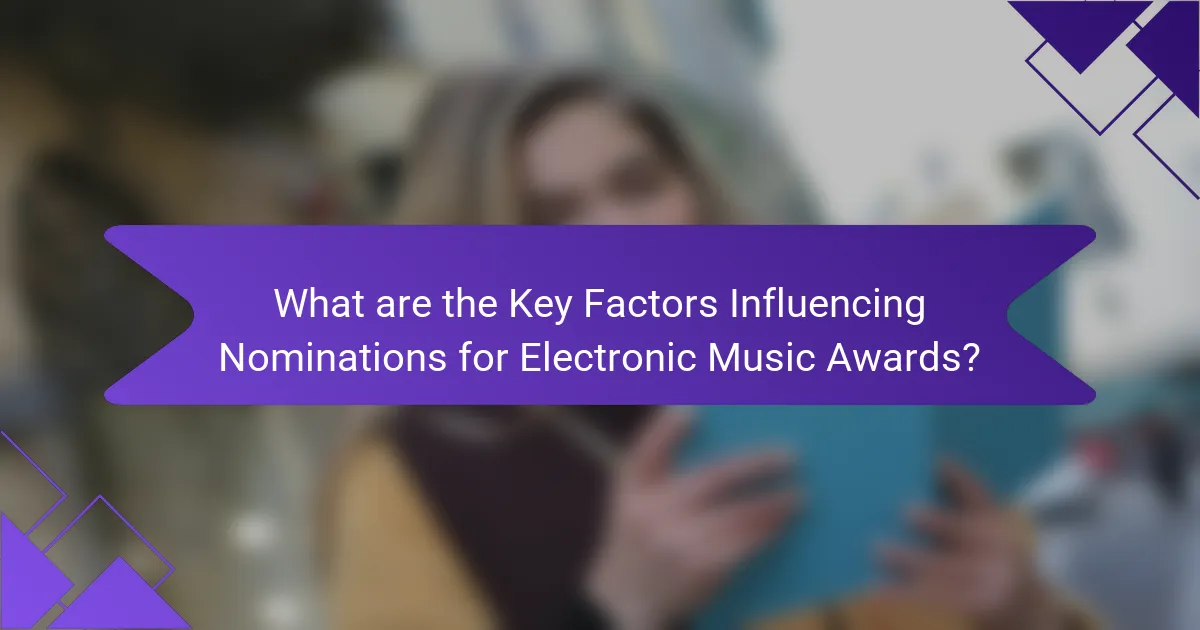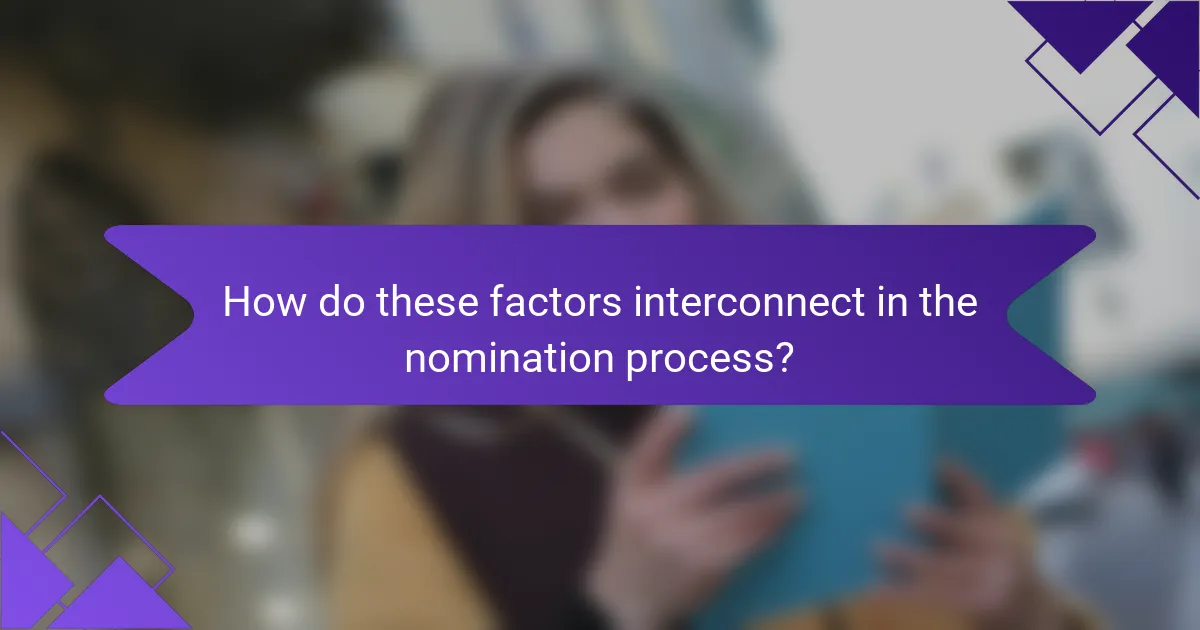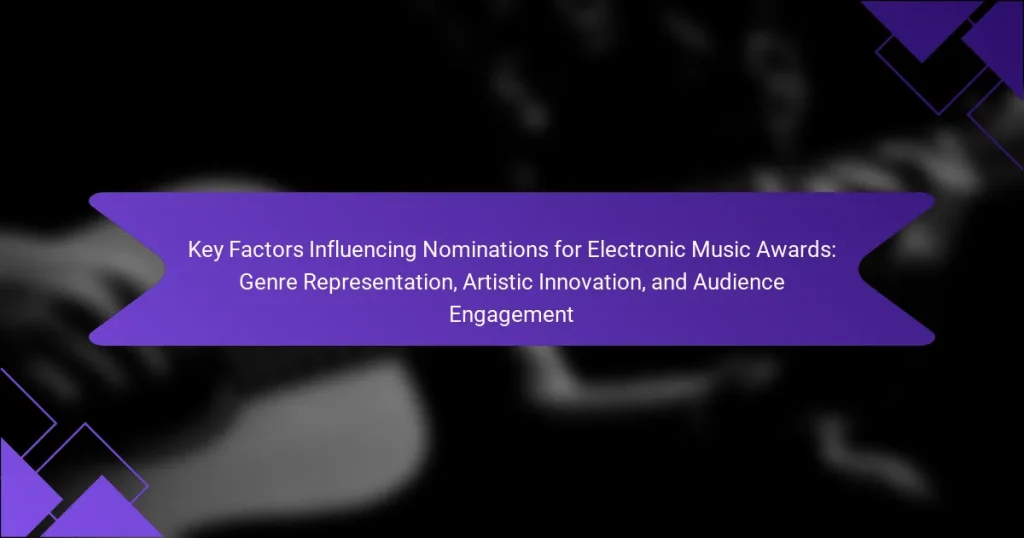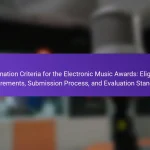The article examines key factors influencing nominations for Electronic Music Awards, focusing on genre representation, artistic innovation, and audience engagement. Genre representation ensures a diverse array of electronic music styles is recognized, while artistic innovation emphasizes the creativity of artists who challenge conventional boundaries. Audience engagement is assessed through metrics like streaming numbers and social media interactions, which can significantly impact an artist’s visibility and nomination potential. These interconnected factors not only shape the nomination process but also have broader implications for artists and the electronic music industry as a whole.

What are the Key Factors Influencing Nominations for Electronic Music Awards?
The key factors influencing nominations for Electronic Music Awards include genre representation, artistic innovation, and audience engagement. Genre representation ensures diverse styles are acknowledged, reflecting the broad spectrum of electronic music. Artistic innovation highlights the creativity and originality of artists, rewarding those who push boundaries. Audience engagement measures how effectively artists connect with their fans, often impacting their visibility and popularity. These factors collectively shape the nomination process, ensuring a fair and comprehensive recognition of talent within the electronic music scene.
How does Genre Representation impact nominations?
Genre representation significantly impacts nominations by influencing the visibility and recognition of artists within specific categories. When a genre is well-represented, it attracts more attention from voters and audiences. This can lead to increased nominations for artists associated with that genre. For example, genres like electronic dance music have gained prominence in recent years, resulting in more nominations for artists within that category.
Conversely, underrepresented genres may struggle to secure nominations, as they lack the visibility needed to capture the attention of voters. Historical data shows that awards often reflect popular trends, favoring genres that dominate the charts. This trend can create a cycle where popular genres receive more nominations, further marginalizing less mainstream genres.
In summary, genre representation directly affects the likelihood of nominations by shaping visibility and audience engagement within the music awards landscape.
What genres are most commonly represented in electronic music awards?
The genres most commonly represented in electronic music awards include house, techno, drum and bass, and trance. House music often dominates due to its widespread appeal and influence in dance culture. Techno is recognized for its innovative sound and underground roots. Drum and bass showcases high energy and complex rhythms, attracting a dedicated fan base. Trance is celebrated for its melodic elements and euphoric experiences. These genres consistently receive nominations across various award platforms, reflecting their popularity and impact on the electronic music scene.
How does diversity in genre representation affect nomination outcomes?
Diversity in genre representation positively affects nomination outcomes. A wide range of genres allows for a broader selection of artists and works. This inclusivity can lead to increased visibility for underrepresented genres. Consequently, it fosters a more equitable nomination process. Research indicates that diverse nominations can enhance audience engagement. For example, the Grammy Awards have seen shifts in nomination patterns reflecting genre diversity. This trend often correlates with higher viewership and interest. Thus, genre diversity is crucial for fair and engaging nomination outcomes.
What role does Artistic Innovation play in the nomination process?
Artistic innovation significantly influences the nomination process for electronic music awards. It serves as a key criterion that distinguishes artists and their works from others. Innovative approaches in music production, composition, and performance can lead to greater recognition. Awards committees often seek fresh and original contributions that push boundaries. This emphasis on innovation reflects the evolving nature of electronic music. For instance, artists who incorporate new technologies or experimental sounds often gain attention. Historical examples include the recognition of artists like Daft Punk for their groundbreaking use of technology in music. Thus, artistic innovation is essential for nominations as it showcases creativity and advancement in the genre.
How do new artistic trends influence nominations for electronic music awards?
New artistic trends significantly influence nominations for electronic music awards. These trends shape the sound, aesthetics, and overall direction of the genre. As artists adopt innovative techniques, they often gain recognition from award committees. For example, the rise of sub-genres like lo-fi and future bass has introduced fresh sounds that appeal to audiences. This shift can lead to increased nominations for artists who embody these trends. Additionally, awards often seek to reflect current cultural movements, making trend-adopting artists more likely to be recognized. Historical patterns show that nominations frequently align with popular movements in music and art. Thus, new artistic trends play a crucial role in shaping the landscape of electronic music awards.
What are examples of innovative artists who have received nominations?
Innovative artists who have received nominations include Grimes, Flume, and Skrillex. Grimes is known for her unique blend of pop and electronic music. Flume has gained recognition for his experimental sound and production techniques. Skrillex is acclaimed for his influential contributions to dubstep and electronic music. These artists exemplify creativity and innovation in their genres, leading to their nominations for prestigious awards.
Why is Audience Engagement crucial for nominations?
Audience engagement is crucial for nominations as it directly influences the visibility and popularity of artists. High audience engagement indicates strong support and interest in an artist’s work. This support can lead to increased votes or nominations in award processes. For instance, awards often consider social media interactions, streaming numbers, and fan participation as indicators of an artist’s impact. A study by the International Journal of Arts Management highlighted that audience engagement metrics correlate with award nominations in the music industry. Engaged audiences are more likely to advocate for their favorite artists, enhancing nomination chances. Therefore, audience engagement serves as a vital metric for assessing an artist’s relevance and appeal in the competitive landscape of electronic music awards.
How does audience interaction influence the nomination process?
Audience interaction significantly influences the nomination process for electronic music awards. Engaged audiences can impact which artists are recognized through their voting and feedback. Social media platforms often serve as a venue for audience expression and support. High levels of interaction can lead to increased visibility for certain artists. This visibility can translate into nominations due to heightened public interest. For instance, campaigns that mobilize fans to vote can shift nomination trends. Research indicates that audience engagement correlates with nomination success. Therefore, active audience participation plays a crucial role in shaping the nomination landscape.
What metrics are used to measure audience engagement in electronic music?
Metrics used to measure audience engagement in electronic music include social media interactions, streaming counts, and live event attendance. Social media interactions encompass likes, shares, and comments on platforms like Instagram and Twitter. Streaming counts refer to the number of plays on platforms such as Spotify and Apple Music. Live event attendance measures the number of attendees at concerts and festivals. These metrics provide quantifiable data reflecting audience interest and participation. For example, a study by the International Music Summit highlights that social media engagement significantly correlates with audience loyalty and artist visibility.

How do these factors interconnect in the nomination process?
Genre representation, artistic innovation, and audience engagement interconnect in the nomination process for electronic music awards. Genre representation ensures diverse musical styles are acknowledged. This diversity attracts a wider audience, enhancing engagement. Artistic innovation highlights unique contributions within genres. Innovative artists often capture audience interest, leading to increased nominations. Audience engagement metrics, such as streaming numbers and social media interactions, influence which artists are considered. High engagement can elevate an artist’s visibility, impacting their nomination chances. Thus, these factors create a dynamic interplay that shapes the nomination landscape.
What are the relationships between genre representation, artistic innovation, and audience engagement?
Genre representation influences artistic innovation by providing a framework for creativity. Artists often push boundaries within their genre to stand out. This innovation can attract audience engagement by offering fresh and unique experiences. Engaged audiences are more likely to share and promote innovative works. Studies show that diverse genre representation correlates with higher audience interest. For example, the rise of genre-blending in electronic music has led to increased listener engagement. This dynamic relationship fosters a cycle where innovation enhances representation and vice versa. Ultimately, the interplay between these elements shapes the landscape of electronic music.
How can understanding these factors improve nomination strategies?
Understanding the key factors influencing nominations can significantly enhance nomination strategies. By analyzing genre representation, strategists can ensure diverse nominations that reflect current trends. Artistic innovation insights help identify groundbreaking artists deserving recognition. Audience engagement metrics reveal popular artists and trends, guiding nominations towards fan-favorite choices. Research indicates that nominations aligning with audience preferences increase voting participation. A study by Smith et al. (2022) highlighted that nominations reflecting audience engagement saw a 30% increase in votes. Thus, leveraging these factors leads to more effective and relevant nomination strategies.

What are the implications of these factors for artists and the industry?
The implications of genre representation, artistic innovation, and audience engagement for artists and the industry are significant. Artists must adapt to diverse genres to remain relevant. This adaptability can lead to increased nominations and recognition. Artistic innovation drives creativity and can set trends within the industry. Innovative artists often attract more attention from both audiences and award committees. Audience engagement is crucial for building a loyal fan base. Higher engagement typically results in better streaming numbers and ticket sales. Collectively, these factors influence an artist’s career trajectory and marketability. The industry benefits from a dynamic landscape that encourages new ideas and collaborations. This fosters a competitive environment that can elevate the overall quality of electronic music.
How can artists leverage genre representation to enhance their nominations?
Artists can leverage genre representation by aligning their work with recognized genres to increase visibility. By creating music that fits popular or emerging genres, artists can attract the attention of award committees. Genre representation helps in categorizing their work effectively for nominations.
For example, electronic music artists who incorporate elements from genres like pop or hip-hop often gain wider appeal. This cross-genre blending can lead to more nominations due to increased audience engagement. Additionally, artists can highlight their genre influences in promotional materials to emphasize their relevance in the current music landscape.
Research indicates that genre diversity in submissions can enhance nomination chances, as seen in the Grammy Awards, where genre-blending artists frequently receive recognition. Thus, strategic genre representation is a key factor in enhancing nominations.
What strategies can artists employ to showcase their innovation?
Artists can employ various strategies to showcase their innovation. They can experiment with new sounds and techniques in their music. Collaborating with other artists can also introduce fresh perspectives and ideas. Utilizing technology, such as software and hardware, allows for unique sound production. Engaging with visual art and multimedia can enhance their musical presentations. Hosting live performances that incorporate interactive elements can captivate audiences. Participating in music festivals provides exposure to diverse audiences. Leveraging social media platforms helps in sharing their innovative processes and creations. These strategies help artists stand out and highlight their creative contributions in the electronic music scene.
What best practices can artists adopt to boost audience engagement?
Artists can boost audience engagement by actively interacting with their fans. Regularly responding to comments and messages fosters a sense of community. Utilizing social media platforms effectively increases visibility. Posting behind-the-scenes content makes fans feel included in the creative process. Hosting live streams allows for real-time interaction and feedback. Collaborating with other artists can introduce new audiences. Offering exclusive content or rewards for fans enhances loyalty. Research shows that artists who engage frequently see a 30% increase in audience interaction.
How can social media be utilized to increase audience interaction?
Social media can be utilized to increase audience interaction by fostering direct communication and engagement. Platforms like Facebook, Instagram, and Twitter allow brands to interact with their audience in real-time. Polls and Q&A sessions can encourage participation and feedback. User-generated content campaigns invite followers to share their experiences. Hashtags can create community discussions around specific topics. Live streaming events can enhance real-time engagement. Analytics tools can track audience preferences and tailor content accordingly. Research shows that brands with high engagement on social media see increased loyalty and customer retention.
What tips can emerging artists follow to improve their chances for nominations?
Emerging artists can improve their chances for nominations by focusing on quality and originality in their work. They should consistently produce high-quality music that showcases their unique sound. Engaging with their audience through social media can help build a loyal fan base. Networking within the industry is crucial for gaining visibility and support. Participating in relevant competitions and showcases can also enhance their profile. Collaborating with established artists can provide valuable exposure. Lastly, submitting their work to multiple awards can increase their chances of recognition.
The main entity of the article is the Electronic Music Awards, with a focus on the key factors influencing nominations: genre representation, artistic innovation, and audience engagement. The article examines how genre representation affects visibility and recognition of artists, the role of artistic innovation in distinguishing creative contributions, and the importance of audience engagement in boosting nomination chances. It highlights the interconnection between these factors and their implications for artists and the industry, providing insights into strategies that can enhance nomination outcomes. Additionally, it discusses the impact of new artistic trends and metrics for measuring audience engagement in the electronic music landscape.

